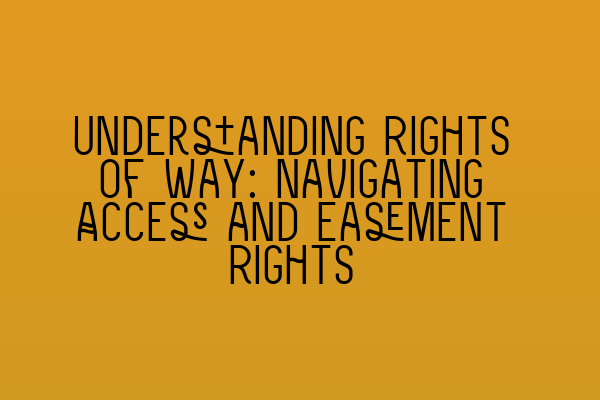Understanding Rights of Way: Navigating Access and Easement Rights
As a solicitor practicing property law, I often come across cases involving rights of way, which can sometimes be a complex and contentious area of law. Understanding the intricacies of access and easement rights is important for both property owners and those seeking access to neighbouring properties. In this blog post, I will provide a comprehensive overview of rights of way, explaining the different types of rights, how they are created, and how they can be protected.
1. What is a Right of Way?
A right of way is a legal right that allows a person to pass through another person’s land for a specific purpose. It is important to note that a right of way does not confer ownership of the land; it only grants the right to passage. Rights of way can be created for various purposes, such as accessing a neighbouring property, reaching a public road, or accessing utilities.
2. Types of Rights of Way
There are two main types of rights of way: public and private.
– Public Rights of Way: Public rights of way are established when a route has been historically used by the public for an extended period. These rights are created by prescription, meaning that they have been exercised without interruption for a certain period of time. Public rights of way are typically found in rural areas and can include footpaths, bridleways, and byways.
– Private Rights of Way: Private rights of way are specific to individuals or properties and are usually created by a formal agreement, known as an easement. These rights are typically associated with accessing a property or a specific area of land. Private rights of way can be established through a deed, a will, or by necessity.
3. Creating a Right of Way
To create a private right of way, the owner of the land granting the right (the servient land) and the owner of the land benefiting from the right (the dominant land) must agree to the terms of the easement. This agreement should be recorded in writing and included in the respective property deeds. It is essential to consult a solicitor during this process to ensure that all legal requirements are met.
4. Protecting Rights of Way
Rights of way can be protected through the legal principle of “enjoyment without interruption.” If a right of way has been exercised without interruption for a certain period, it may become an “easement by prescription.” This means that the right has been established through long-term use, and it can be enforced even if there is no written agreement.
To protect a right of way, it is crucial to ensure that it is clearly outlined in the property deeds and registered with the Land Registry. This will provide legal evidence of the existence of the right and help prevent any potential disputes in the future. Seeking legal advice and assistance from a property law solicitor is advisable to navigate the complexities of registering and protecting rights of way.
5. Resolving Disputes
Disputes relating to rights of way often arise due to disagreements over their scope, maintenance responsibilities, or changes in land use. If a dispute cannot be resolved amicably between the parties involved, it may be necessary to seek legal recourse. A solicitor experienced in property law can provide guidance and represent their clients in negotiations or court proceedings if needed.
In conclusion, understanding rights of way is essential for anyone involved in property ownership or requiring access to neighbouring properties. Whether it is a public right of way or a private right of way created by an easement, it is crucial to document and protect these rights to prevent potential disputes in the future. Seeking professional legal advice is highly recommended to navigate the intricacies of creating, protecting, and resolving disputes related to rights of way.
For more information on property law and related topics, take a look at our other articles:
– SQE 1 Practice Exam Questions
– SQE 1 Practice Mocks FLK1 FLK2
– SQE 2 Preparation Courses
– SQE 1 Preparation Courses
– SRA SQE Exam Dates
At SQE Property Law & Land Law, we are dedicated to providing expert legal advice and assistance in property matters. Contact us today to schedule a consultation with our experienced solicitors.
